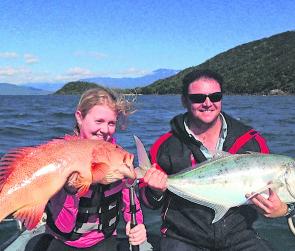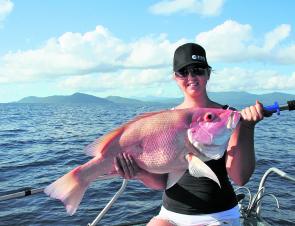August usually heralds the easing of the southeasterly winds that dominate the weather pattern in Cairns each winter. There is usually at least one final cold snap before the temperatures start to rise, so there can be a wide range of conditions on offer.
The cold snaps will see the mackerel action continue, while any warm patches will stir the more tropical species into action. Whatever the temperature, it is the wind that will be the key ingredient. When the wind is down, the fish will come out to play but when it blows you are better off focusing on your favourite footy code.
Offshore is the place to be this month, so plan your attack based on the wind and forget about the moon and tides. The action will be wide spread, with trout feeding up in the shallows, big mouth nannygai and red emperor on the chew in the deep water and mackerel chasing bait all over the place.
Quality trout in the 3-5kg range will be moving onto the shallow bommies but they are often hit hard by the live trout boats. If things are quiet in waters under 30m, look for heavy country in the 30-45m range. This is a bit too deep for live trout fishing and can often prove the saviour when the local reefs have been scoured by the live trout dories.
Focus your red fishing in the 40m+ range, especially at night. Trophy-sized big mouth nannygai, over the 7kg mark, will be on offer this month and can be taken in good numbers, usually with a sprinkling of quality red emperor to really spice up the ice box. Look for isolated bommies, rubble patches and gutters in the deep water, between the reefs, for the best results. Reds are often schooling this month, so watch the sounder for bait schools and big fish marking. Large big mouth nannygai often show as isolated arches up to a third of the way off the bottom, so try any spots that show this scenario on the screen.
Be prepared to move if necessary, as sharks have been a real problem in recent years. Bull and whaler sharks have been the main offenders and have been known to follow boats that try to give them the slip. Be prepared to get up on the plane and move more than 1km if you want to have any chance of shaking them off your trail. It can also pay to fish with heavier handlines, rather than rods, so fish can be brought to the surface quickly. Sharks must have simular taste to humans, as they always seem to nail the trophy fish, like trout, red emperor and big mouth nannygai, but seem happy to let pick fish, trevally, Chinaman and red bass slip through the razor gauntlet.
Mackerel will be spread from the outer reef to the inshore grounds, so always have a floater out the back when bottom bashing. The humble pillie can be incredibly productive at times and there are a few techniques that will increase your chances of taking home a Spaniard. Use a small float that keeps the pilchard at least 3m below the surface. Balloons can break the line when hit hard, unless they are set up to break off easily. Small in-line floats are best but make sure they can readily be made to slide down the line when they come to the rod tip. Use chained hooks in the 6/0 to 8/0 range and no steel trace, unless the mackerel are thick. A couple of metres of fluorocarbon leader, tied straight onto braid, main line, is ideal.
Live baits are always worth a go but can sometimes be a nuisance when bottom fishing, as they take a bit more time and effort to rig and supervise. I often put a pillie out straight away but have a live bait rig made up, ready to use, if a suitable pick fish like a hussar, fusilier, goat fish, grinner or small trevally, comes over the side.
The serious mackerel chasers will find plenty of action this month, with all methods of attack producing the goods at various times. In recent years the humble mackerel spoon has been taking more than its fair share of mackerel, so don’t discount having one in your spread when trolling. They are particularly effective on the lesser mackerel, like greys, spotties and doggies but will also account for plenty of Spaniards at times.
The dedicated pelagic fishos will do well trolling a mixture of hardbody lures, skipping garfish, skirted lures and swimming mullet or gar for a variety of species, ranging from small black marlin, Spanish mackerel, spotted mackerel, northern blue fin tuna, mac tuna, gold spot trevally, giant trevally and green jobfish.
Metal slugs have also been working a treat when tossed into surface feeding schools of pelagics. This approach is great fun for those who also like a serious work out as part of their fishing package. Small black marlin have been showing up in good numbers in August in recent years, with last year’s Fitzroy Island tournament accounting for an incredible 130 blacks in just three days of competition.
In the estuaries, while the water temperature stays low, the humble bream will be the mainstay. Any artificial structure, rock, rubble and mangrove area will be worth a look. Grunter, trevally and queenfish will also be lurking in the main channels, with the rising tide usually the most productive.
Once the water temperature starts to rise, the tropical trophy trio of barra, golden snapper and mangrove jack will become more prominent, with both live baits and lures accounting for their fair share, at various times. Jacks and golden snapper tend to be more active than barra in the cooler temperatures, so start looking for these two species first, then shift your focus to barra as the water temperature climbs over 26ºC. Keep in mind that all three species can be caught all year round, if you are prepared to put in the time and effort.
If the wind is below 20 knots, fish towards the mouth of the systems but when it’s howling and pushing a lot of dirty water into the streams, with the rising tide, it can be more productive to fish the deeper holes further upstream.
Reads: 1514
Kim Leo, 11yo from Emerald, caught this magnificent coral trout on a charter with Blackout Sportsfishing while holidaying in Mareeba with her dad Gavin, shown holding the trevally.

Trophy-sized big mouth nannygai will be on offer this month in the deep water off Cairns.




